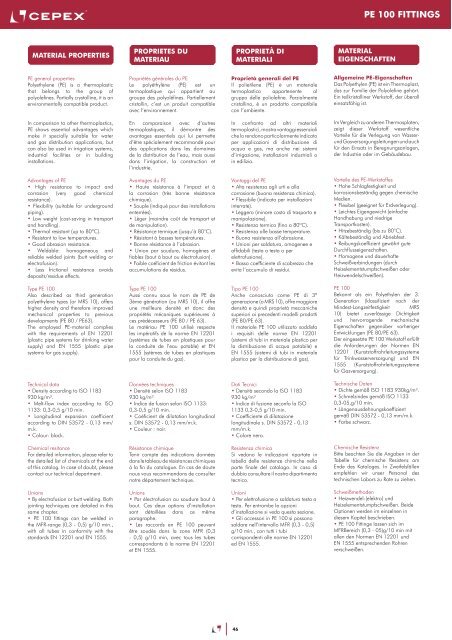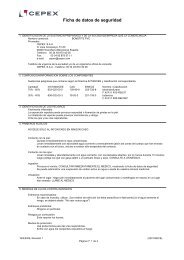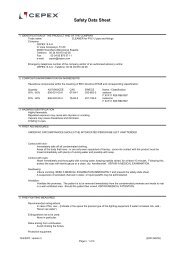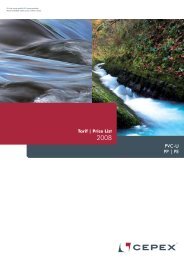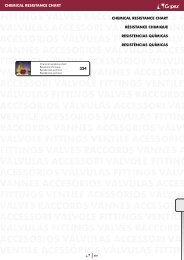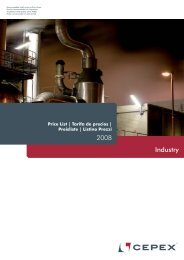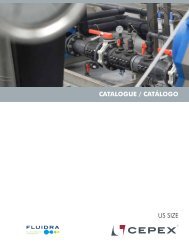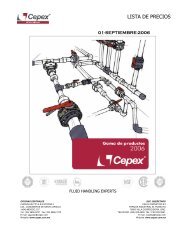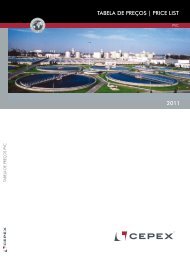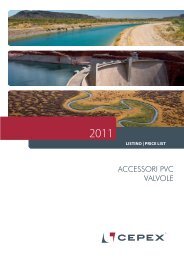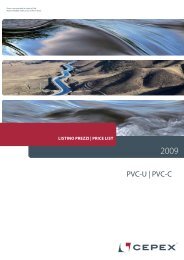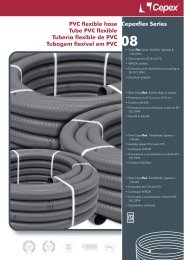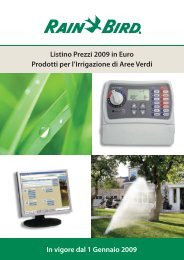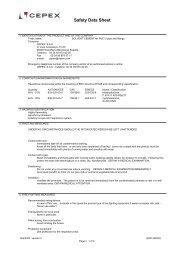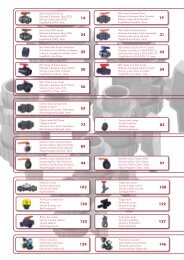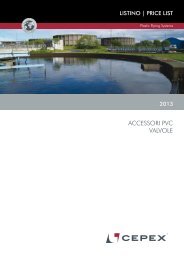PP | PE - Cepex
PP | PE - Cepex
PP | PE - Cepex
Create successful ePaper yourself
Turn your PDF publications into a flip-book with our unique Google optimized e-Paper software.
MATERIAL PRO<strong>PE</strong>RTIES<br />
<strong>PE</strong> general properties<br />
Polyethylene (<strong>PE</strong>) is a thermoplastic<br />
that belongs to the group of<br />
polyolefines. Partially crystalline, it is an<br />
environmentally compatible product.<br />
In comparison to other thermoplastics,<br />
<strong>PE</strong> shows essential advantages which<br />
make it specially suitable for water<br />
and gas distribution applications, but<br />
can also be used in irrigation systems,<br />
industrial facilities or in building<br />
installations.<br />
Advantages of <strong>PE</strong><br />
• High resistance to impact and<br />
corrosion (very good chemical<br />
resistance).<br />
• Flexibility (suitable for underground<br />
piping).<br />
• Low weight (cost-saving in transport<br />
and handling).<br />
• Thermal resistant (up to 80ºC).<br />
• Resistant to low temperatures.<br />
• Good abrasion resistance.<br />
• Weldable: homogeneous and<br />
reliable welded joints (butt welding or<br />
electrofusion).<br />
• Less frictional resistance avoids<br />
deposits/residue effects.<br />
Type <strong>PE</strong> 100<br />
Also described as third generation<br />
polyethylene types (or MRS 10), offers<br />
higher density and therefore improved<br />
mechanical properties to previous<br />
developments (<strong>PE</strong> 80 / <strong>PE</strong>63).<br />
The employed <strong>PE</strong>-material complies<br />
with the requirements of EN 12201<br />
(plastic pipe systems for drinking water<br />
supply) and EN 1555 (plastic pipe<br />
systems for gas supply).<br />
Technical data<br />
• Density according to ISO 1183<br />
930 kg/m³.<br />
• Melt-flow index according to ISO<br />
1133: 0,3-0,5 g/10 min.<br />
• Longitudinal expansion coefficient<br />
according to DIN 53572 - 0,13 mm/<br />
m.k.<br />
• Colour: black.<br />
Chemical resitance<br />
For detailed information, please refer to<br />
the detailed list of chemicals at the end<br />
of this catalog. In case of doubt, please<br />
contact our technical department.<br />
Unions<br />
• By electrofusion or butt welding. Both<br />
jointing techniques are detailed in this<br />
same chapter.<br />
• <strong>PE</strong> 100 fittings can be welded in<br />
the MFR-range (0,3 - 0,5) g/10 min.,<br />
with all tubes in conformity with the<br />
standards EN 12201 and EN 1555.<br />
PROPRIETES DU<br />
MATERIAU<br />
Propriétés générales du <strong>PE</strong><br />
Le polyéthylène (<strong>PE</strong>) est un<br />
termoplastique qui appartient au<br />
groupe des polyoléfines. Partiellement<br />
cristallin, c’est un produit compatible<br />
avec l’environnement.<br />
En comparaison avec d’autres<br />
termoplastiques, il démontre des<br />
avantages essentiels qui lui permette<br />
d’être spécialement recommandé pour<br />
des applications dans les domaines<br />
de la distribution de l’eau, mais aussi<br />
dans l’irrigation, la construction et<br />
l’industrie.<br />
Avantages du <strong>PE</strong><br />
• Haute résistance à l’impact et à<br />
la corrosion (très bonne résistance<br />
chimique).<br />
• Souple (indiqué pour des installations<br />
enterrées).<br />
• Lèger (moindre coût de transport et<br />
de manipulation).<br />
• Résistance termique (jusqu’à 80°C).<br />
• Résistant à basses températures.<br />
• Bonne résistance à l’abrasion.<br />
• Union par soudure, homogènes et<br />
fiables (bout à bout ou électrofusion).<br />
• Faible coéficient de friction évitant les<br />
accumulations de résidus.<br />
Type <strong>PE</strong> 100<br />
Aussi connu sous le nom de <strong>PE</strong> de<br />
3ème génération (ou MRS 10), il offre<br />
une meilleure densité et donc des<br />
propriétés mécaniques supérieures à<br />
ces prédécesseurs (<strong>PE</strong> 80 / <strong>PE</strong> 63).<br />
Le matériau <strong>PE</strong> 100 utilisé respecte<br />
les impératifs de la norme EN 12201<br />
(systèmes de tubes en plastiques pour<br />
la conduite de l’eau potable) et EN<br />
1555 (sytèmes de tubes en plastiques<br />
pour la conduite du gaz).<br />
Données techniques<br />
• Densité selon ISO 1183<br />
930 kg/m³<br />
• Indice de fusion selon ISO 1133:<br />
0,3-0,5 g/10 min.<br />
• Coéficient de dilatation longitudinal<br />
s. DIN 53572 - 0,13 mm/m.k.<br />
• Couleur : noir.<br />
Résistance chimique<br />
Tenir compte des indications données<br />
dans le tableau de résistances chimiques<br />
à la fin du catalogue. En cas de doute<br />
nous vous recommandons de consulter<br />
notre département technique.<br />
Unions<br />
• Par électrofusion ou soudure bout à<br />
bout. Ces deux options d’installation<br />
sont détaillées dans ce même<br />
paragraphe.<br />
• Les raccords en <strong>PE</strong> 100 peuvent<br />
être soudés dans la zone MFR (0,3<br />
- 0,5) g/10 min, avec tous les tubes<br />
correspondants à la norme EN 12201<br />
et EN 1555.<br />
PROPRIETÀ DI<br />
MATERIALI<br />
Proprietà generali del <strong>PE</strong><br />
Il polietilene (<strong>PE</strong>) è un materiale<br />
termoplastico appartenente al<br />
gruppo delle poliolefine. Parzialmente<br />
cristallino, è un prodotto compatibile<br />
con l’ambiente.<br />
In confronto ad altri materiali<br />
termoplastici, mostra vantaggi essenziali<br />
che lo rendono particolarmente indicato<br />
per applicazioni di distribuzione di<br />
acqua e gas, ma anche nei sistemi<br />
d’irrigazione, installazioni industriali o<br />
in edilizia.<br />
Vantaggi del <strong>PE</strong><br />
• Alta resistenza agli urti e alla<br />
corrosione (buona resistenza chimica).<br />
• Flessibile (indicato per installazioni<br />
interrate).<br />
• Leggero (minore costo di trasporto e<br />
manipolazione).<br />
• Resistenza termica (fino a 80ºC).<br />
• Resistenza alle basse temperature.<br />
• Buona resistenza all’abrasione.<br />
• Unioni per saldatura, omogenee e<br />
affidabili (testa a testa o per<br />
elettrofusione).<br />
• Basso coefficiente di scabrezza che<br />
evita l’accumulo di residui.<br />
Tipo <strong>PE</strong> 100<br />
Anche conosciuto come <strong>PE</strong> di 3ª<br />
generazione (o MRS 10), offre maggiore<br />
densità e quindi proprietà meccaniche<br />
superiori ai precedenti modelli prodotti<br />
(<strong>PE</strong> 80/<strong>PE</strong> 63).<br />
Il materiale <strong>PE</strong> 100 utilizzato soddisfa<br />
i requisiti delle norme EN 12201<br />
(sistemi di tubi in materiale plastico per<br />
la distribuzione di acqua potabile) e<br />
EN 1555 (sistemi di tubi in materiale<br />
plastico per la distribuzione di gas).<br />
Dati Tecnici<br />
• Densità secondo la ISO 1183<br />
930 kg/m³<br />
• Indice di fusione seconfo la ISO<br />
1133 0,3-0,5 g/10 min.<br />
• Coefficiente di dilatazione<br />
longitudinale s. DIN 53572 - 0,13<br />
mm/m.k.<br />
• Colore nero.<br />
Resistenza chimica<br />
Si vedano le indicazioni riportate in<br />
tabella delle resistenze chimiche nella<br />
parte finale del catalogo. In caso di<br />
dubbio consultare il nostro dipartimento<br />
tecnico.<br />
Unioni<br />
• Per elettrofusione o saldatura testa a<br />
testa. Per entrambe le opzioni<br />
d’installazione si veda questa sezione.<br />
• Gli accessori in <strong>PE</strong> 100 si possono<br />
saldare nell’intervallo MFR (0,3 - 0,5)<br />
g/10 min., con tutti i tubi<br />
corrispondenti alle norme EN 12201<br />
ed EN 1555.<br />
46<br />
<strong>PE</strong> 100 FITTINGS<br />
MATERIAL<br />
EIGENSCHAFTEN<br />
Allgemeine <strong>PE</strong>-Eigenschaften<br />
Das Polyethylen (<strong>PE</strong>) ist ein Thermoplast,<br />
das zur Familie der Polyolefine gehört.<br />
Ein teilkristalliner Werkstoff, der überall<br />
einsatzfähig ist.<br />
Im Vergleich zu anderen Thermosplaten,<br />
zeigt dieser Werkstoff wesentliche<br />
Vorteile für die Verlegung von Wasser-<br />
und Gasversorgungsleitungen und auch<br />
für den Einsatz in Beregnungsanlagen,<br />
der Industrie oder im Gebäudebau.<br />
Vorteile des <strong>PE</strong>-Werkstoffes<br />
• Hohe Schlagfestigkeit und<br />
korrosionsbeständig gegen chemische<br />
Medien.<br />
• Flexibel (geeignet für Erdverlegung).<br />
• Leichtes Eigengewicht (einfache<br />
Handhabung und niedrige<br />
Transportkosten).<br />
• Hitzebeständig (bis zu 80°C).<br />
• Kältebeständig und Abriebfest.<br />
• Reibungskoeffizient gewährt gute<br />
Durchflusseigenschaften.<br />
• Homogene und dauerhafte<br />
Schweißverbindungen (durch<br />
Heizelementstumpfschweißen oder<br />
Heizwendelschweißen).<br />
<strong>PE</strong> 100<br />
Bekannt als ein Polyethylen der 3.<br />
Generation (klassifiziert nach der<br />
Mindest-Langzeitfestigkeit MRS<br />
10) bietet zuverlässige Dichtigkeit<br />
und hervorragende mechanische<br />
Eigenschaften gegenüber vorheriger<br />
Entwicklungen (<strong>PE</strong> 80/<strong>PE</strong> 63).<br />
Der eingesetzte <strong>PE</strong> 100 Werkstoff erfüllt<br />
die Anforderungen der Normen EN<br />
12201 (Kunststoffrohrleitungssysteme<br />
für Trinkwasserversorgung) und EN<br />
1555 (Kunststoffrohrleitungssysteme<br />
für Gasversorgung).<br />
Technische Daten<br />
• Dichte gemäß ISO 1183 930kg/m³.<br />
• Schmelzindex gemäß ISO 1133<br />
0,3-05,g/10 min.<br />
• Längenausdehnungskoeffizient<br />
gemäß DIN 53572 - 0,13 mm/m.k.<br />
• Farbe schwarz.<br />
Chemische Resistenz<br />
Bitte beachten Sie die Angaben in der<br />
Tabelle für chemische Resistenz am<br />
Ende des Kataloges. In Zweifelsfällen<br />
empfehlen wir unser Personal des<br />
technischen Labors zu Rate zu ziehen.<br />
Schweißmethoden<br />
• Heizwendel-(elektro) und<br />
Heizelementstumpfschweißen. Beide<br />
Optionen werden im einzelnen in<br />
diesem Kapitel beschrieben.<br />
• <strong>PE</strong> 100 Fittinge lassen sich im<br />
MFRBereich (0,3 - 05)g/10 min mit<br />
allen den Normen EN 12201 und<br />
EN 1555 entsprechenden Rohren<br />
verschweißen.


